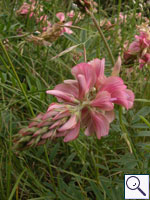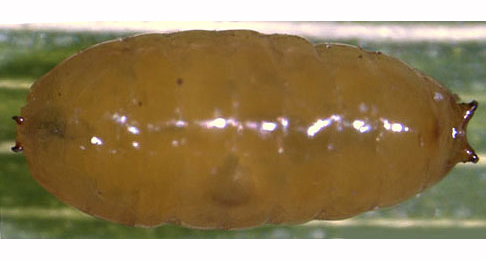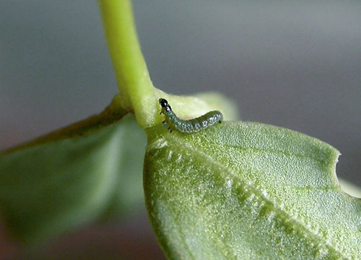|
||||||
|
ONOBRYCHIS. Sainfoins. [Fabaceae] |
|
|
Five species of Onobrychis are recorded in Britain. All are introduced and include Sainfoin (O. viciifolia). Four British miners are recorded on Onobrychis. A key to the European miners recorded on Onobrychis is provided in Bladmineerders van Europa. |
 Sainfoin Onobrychis viciifolia |
|
Key for the identification of the known mines of British |
1a > Leaf-miner: Corridor leaf-mine in leaves. An upper surface linear mine with frass in conspicuous greenish strips, largely alternating at each side of the channel (Spencer, 1976: 241). Upper-surface, unbranched corridor, relatively broad from the start on, but only weakly widening subsequently. The fresh mine is bright green, but turns whitish, later brown, quickly. Frass in a wide green band in the centre of the corridor, with small black granules at either side. Pupation outside the mine. Forms an upper surface mine, with the frass in a green strips. |
 Liriomyza congesta puparium Image: © Willem Ellis (Bladmineerders van Europa) |
|
Liriomyza congesta (Becker, 1903) [Diptera: Agromyzidae]. |
1b > Leaf-miner: The first generation initially forms an unmistakable leaf-mine on Anthyllis vulneraria, but the second generation feeds on the flowers. Feeding signs on other plants vary in appearance. Larvae can move between sewn leaves, and more than one larva may be found together. Larvae in a small full depth blotch, often with extensions. Frass concentrated in one corner of the mine. The mining activities may cause the leaf to roll inwards. Older larvae live free among spun leaves, but still they may make then full depth mines by feeding on the leaf tissue from a small opening. |
 Aproaerema anthyllidella larva, dorsal Image: © Steve Wullaert (Bladmineerders van Europa) |
|
Aproaerema anthyllidella (Hübner, 1813) [Lepidoptera: Gelechiidae]. |
1c > Leaf-miner: In the first instar the larva mines the leaves, forming short, irregular, blotch-like mines, but in later instars it lives externally, feeding in spun leaves and often twisting those of tender shoots. Larval head light-brown or yellowish brown, edged with black postero-laterally, ocellar area blackish; prothoracic plate black edged with whitish anteriorly; abdomen dull dark green; pinacula distinct, black, sometimes brownish but with black bases to setae; anal plate large, black (Bradley et al., 1973). Small, full depth mine without a definite shape; little frass. Some silk is deposited in the mine. The larva soon leaves the mine and continues feeding among spun leaves. |
|
Cnephasia incertana (Treitschke, 1835) [Lepidoptera: Tortricidae]. |
1d > Leaf-miner: Larva producing a short narrow linear mine not associated with the margin, which then develops into a conspicuous white blotch centred on the mid-rib. At the end of feeding the larva lies for one or two days along the mid-rib. Pupation external (Spencer, 1972b: 37 (fig. 114b); Spencer, 1976: 126, fig. 213A). Broad and short hook-like upper-surface corridor, ending in a little blotch in the centre of a leaflet. The blotch is upper-surface as well, but has some deep spots, giving the mine a mottled appearance when hold against the light. Frass in the blotch in a few large lumps. Pupation outside the mine. A short, broad gallery leading to a conspicuous, roundish white blotch in the centre of the leaf. The blotch is upper surface with full depth spots - comprising of large clumps of frass. Puparium reddish |
|
Agromyza nana Meigen, 1830 [Diptera: Agromyzidae]. |
| Last updated 06-Jul-2019 Brian Pitkin | ||
